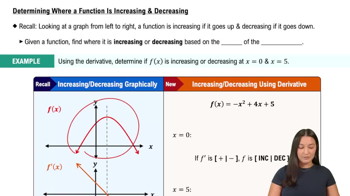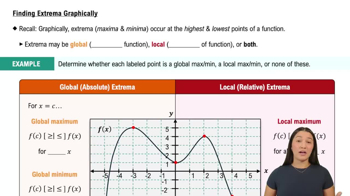Graph f(x) = 2x^4 -4x^2 + 1 and its first two derivatives together. Comment on the behavior of f in relation to the signs and values of f' and f".
Table of contents
- 0. Functions7h 54m
- Introduction to Functions16m
- Piecewise Functions10m
- Properties of Functions9m
- Common Functions1h 8m
- Transformations5m
- Combining Functions27m
- Exponent rules32m
- Exponential Functions28m
- Logarithmic Functions24m
- Properties of Logarithms36m
- Exponential & Logarithmic Equations35m
- Introduction to Trigonometric Functions38m
- Graphs of Trigonometric Functions44m
- Trigonometric Identities47m
- Inverse Trigonometric Functions48m
- 1. Limits and Continuity2h 2m
- 2. Intro to Derivatives1h 33m
- 3. Techniques of Differentiation3h 18m
- 4. Applications of Derivatives2h 38m
- 5. Graphical Applications of Derivatives6h 2m
- 6. Derivatives of Inverse, Exponential, & Logarithmic Functions2h 37m
- 7. Antiderivatives & Indefinite Integrals1h 26m
- 8. Definite Integrals4h 44m
- 9. Graphical Applications of Integrals2h 27m
- 10. Physics Applications of Integrals 3h 16m
- 11. Integrals of Inverse, Exponential, & Logarithmic Functions2h 31m
- 12. Techniques of Integration7h 41m
- 13. Intro to Differential Equations2h 55m
- 14. Sequences & Series5h 36m
- 15. Power Series2h 19m
- 16. Parametric Equations & Polar Coordinates7h 58m
5. Graphical Applications of Derivatives
The First Derivative Test
Problem 4.3.33
Textbook Question
Identifying Extrema
In Exercises 19–40:
a. Find the open intervals on which the function is increasing and those on which it is decreasing.
b. Identify the function’s local extreme values, if any, saying where they occur.
g(x) = x√8 − x²
 Verified step by step guidance
Verified step by step guidance1
To find the intervals where the function is increasing or decreasing, first find the derivative of the function g(x) = x√(8 - x²). Use the product rule and chain rule to differentiate.
Set the derivative equal to zero to find the critical points. These points will help determine where the function changes from increasing to decreasing or vice versa.
Analyze the sign of the derivative on the intervals determined by the critical points. If the derivative is positive on an interval, the function is increasing there; if negative, the function is decreasing.
To identify local extrema, evaluate the function at the critical points. Use the first derivative test to determine if these points are local maxima or minima.
Summarize the intervals of increase and decrease, and list any local extrema along with their locations based on the analysis of the derivative and critical points.
 Verified video answer for a similar problem:
Verified video answer for a similar problem:This video solution was recommended by our tutors as helpful for the problem above
Video duration:
5mPlay a video:
Was this helpful?
Key Concepts
Here are the essential concepts you must grasp in order to answer the question correctly.
Derivative and Critical Points
The derivative of a function provides information about its rate of change. To find where a function is increasing or decreasing, calculate its derivative and identify critical points where the derivative is zero or undefined. These points are potential locations for local extrema and help determine intervals of increase or decrease.
Recommended video:

Critical Points
Increasing and Decreasing Intervals
A function is increasing on an interval if its derivative is positive over that interval, and decreasing if the derivative is negative. By analyzing the sign of the derivative across different intervals, you can determine where the function rises or falls, which is crucial for identifying behavior patterns in the function.
Recommended video:

Determining Where a Function is Increasing & Decreasing
Local Extrema
Local extrema refer to the local maximum or minimum values of a function within a specific interval. These occur at critical points where the derivative changes sign. To identify local extrema, evaluate the function at critical points and use the first or second derivative test to confirm whether these points are maxima or minima.
Recommended video:

Finding Extrema Graphically

 7:32m
7:32mWatch next
Master Determining Where a Function is Increasing & Decreasing with a bite sized video explanation from Patrick
Start learningRelated Videos
Related Practice
Textbook Question
